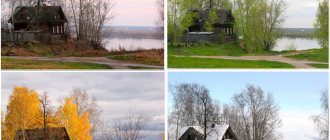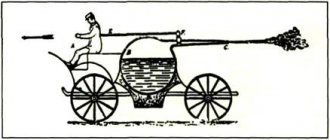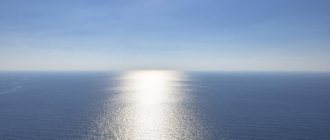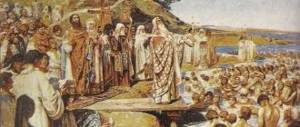Lesson from “Seascape” (4th grade)
Lesson #6
art
Subject:
Seascape
Target:
Development of imaginative thinking, imagination, ability to reason, analyze works of art.
Objectives:
1. To introduce students to the work of the marine painter Ivan Konstantinovich Aivazovsky;
with different types of landscape; 2. Expand students’ knowledge about landscape as an independent genre in art; expand the palette of emotional and sensory associations in relation to the color and mood of the picture. 3. Cultivate creative activity, interest in art, accuracy in work 1. Organizational moment.
Today you find yourself in the workshop of young artists. - Do you know who is called an artist? Today we will talk about paintings of nature. -What is the name of the picture in which we see nature painted? ( scenery.)
2. Updating knowledge
Before us is a painting by I.I. Shishkin “Winter” - What do we see in the picture?
“Everything is frozen and immersed in shadow. Only in the depths a ray of sun illuminated the clearing, slightly coloring it in a pinkish tone. This makes the snow, lying in a thick layer on the ground, seem even bluer on the branches of the pine trees. Only dark tree trunks and birds bring life to the picture. — Since the picture shows a forest, we will call such a landscape forest.
Nicholas Roerich painted the painting “Mountain of Five Treasures.” In the painting we see mountains.
-What color did the artist paint them? — Do you think these are high mountains? What do we call the landscape in which we see mountains? mountainous
Our last stop.
We'll stay here longer. Assemble puzzles (in groups) 3. Statement of the topic and objectives of the lesson
The topic of our lesson
– sea
What are the challenges facing us?
4. Work on the topic of the lesson
Drawing the sea is very difficult, because it is changeable; the sea can be seething with advancing waves or calm. The sea is unique every time, the artist can display only a part of it, one of its faces
Didactic game “Identify the sea mood”
The sea has its own laws, The sea has its own habits... With a leaden-gray white crest, Sometimes brooding, light blue, Simply light and simply blue. The sea can be at sunset, sometimes lilac, sometimes reddish. Sometimes silent, sometimes talkative, But it can also be black, Black, rushing, sloping, Incessant and rebellious, Rising and hunchbacked.
- Associative bush “Sea”
Bottomless, boundless, boundless, immense, calm, meek, windless, asleep, sleepy, mysterious, magical, quiet, golden, tender pearl, warm, affectionate, welcoming, friendly, gently alluring, quietly alluring, blue, blue, turquoise, azure, silent, gray, tearful, deceptive, gloomy, gloomy, gray-haired, gloomy, cold, deserted, indifferent, dispassionate, capricious, stormy, boiling, roaring, frantic, raging, violent, rumbling, restless, agitated, alarmed, raging, insidious, merciless, menacing, red-bloody, crimson, pre-sunset, majestic, powerful.
- Marine painters
- - What do we call the landscape on which the sea is painted? sea or "marina"
Artists who paint seascapes are called
marine painters.
The most famous Russian marine painter was
Ivan Konstantinovich Aivazovsky
.
He drew his first ship as a child on the wall of his house. Later, Aivazovsky traveled a lot around the world. Every day at 6 o'clock in the morning he put on a wide robe, stood at the easel, looked at the sea and painted. The artist made 6 thousand paintings during his life, all from life, i.e. looking at the sea. His favorite topics were storms and shipwrecks. Aivazovsky’s most famous painting, “The Ninth Wave,” depicts the morning after a storm: the sea is still raging, but the first rays of the sun have already appeared, the water seems transparent and glowing. “The sun rises over the stormy ocean. The crests of furious waves rise high. One of them is the tallest. Her name is the ninth wave. With terrible force and anger, she seeks to crush and drown a handful of sailors who are frantically clinging to the wreckage of the mast. Who are these unfortunate people, how did they get here? Yesterday morning they left the harbor, it was a clear day. But in the evening a squally wind arose, thunderclaps shook the air. Under this noise, the sound of a breaking ship and the screams of people dying in the waves was inaudible. Every person heard only the beating of his own heart. In the midst of the abyss, they encouraged each other, vowed to exert all their strength and endure until the saving morning, to wait for the sun. It will tame these mad waves! — How did the Artist manage to evoke such feelings in us? (The artist achieves the impression with the help of a set of effects: the image of a handful of people frantically holding on to the wreckage of the mast.) - Do you think there is a chance of saving these sailors? - How does the Artist tell us about this? (The sea in the picture is blue-green, almost emerald - this is the color of hope, peace and salvation. The golden-pink sky tells us about clarification, enlightenment, optimism). A symbol of undying hope and human courage in the face of a formidable and majestic element is the painting “The Ninth Wave” by the most famous Russian marine painter I.K. Aivazovsky. Practical work - Hand preparation (exercises)
What kind of sea would you draw? 1) Explanation and demonstration Using a simple pencil, draw a horizon line that will separate the sky from the earth, you can draw a boat or a sailboat, or maybe you will draw an island or something else. - Where should we start coloring? - Where will the sea be brighter?
- Independent work
- Exhibition of works
5. Summary
Look what a sea you have! Everyone is different. — What is a landscape? -What is the name of the landscape that we painted? — What was the name of the most famous marine painter?
I want to end our lesson with poetry: I see the gentle sea again,
Painted with pink dawn
I hear the seagulls in the open again
And I rejoice: the sea surf is noisy.
Author's didactic game “Define the sea mood”)
Students, listening to a poem, place pictures of seascapes and cards with words that characterize them
.
The sea has its own laws, The sea has its own habits... With a white crest on a sharp fold. Either without a crest, leaden-gray, With small ripples of a goose-like wave, Sometimes thoughtful, light blue, Simply light and simply blue. The sea can be at the hour of sunset Either lilac, or reddish. Sometimes silent, sometimes talkative, With a proud mane at high tide. But it can also be black, Black, rushing, sloping, Incessant and rebellious, Rising and hunchbacked.
- Our first stop is the forest.
Before us is a painting by I.I. Shishkin “Winter” (SLIDE 3)
? what do we see in the picture?
A: giant pine trees, a carpet of snow, fallen trees.
“Everything is frozen and immersed in shadow. Only in the depths a ray of sun illuminated the clearing, slightly coloring it in a pinkish tone. This makes the snow, lying in a thick layer on the ground, seem even bluer on the branches of the pine trees. Only dark tree trunks and birds bring life to the picture.
? It's very quiet in the forest. What can we hear?
A: the cries of birds, the crunch of snow underfoot.
- since the picture shows a forest, we will call such a landscape forest.
- and now we find ourselves in the mountains.
Nicholas Roerich painted the painting “Mountain of Five Treasures” (SLIDE 4)
In the picture we see mountains.
?what color did the artist paint them in?
A: dark blue, almost black close up, greenish-blue with white tops in the distance
? Do you think these are high mountains?
A: Yes, their peaks rise above the clouds
? What do we call the landscape in which we see mountains?
A: mountain
- and this is our last stop - the sea. We'll stay here longer. (SLIDE 5)
- message of new material
3.1. Drawing the sea is very difficult, because it is changeable; the sea can be seething with advancing waves or calm. The sea is unique every time, the artist can display only a part of it, one of its faces
? What do we call the landscape on which the sea is painted?
A: sea or "marina"
3.2. Artists who paint seascapes are called marine painters.
The most famous Russian marine painter was Ivan Konstantinovich Aivazovsky (SLIDE 6). He drew his first ship as a child on the wall of his house. Later, Aivazovsky traveled a lot around the world. Every day at 6 o'clock in the morning he put on a wide robe, stood at the easel, looked at the sea and painted. The artist made 6 thousand paintings during his life, all from life, i.e. looking at the sea. His favorite topics were storms and shipwrecks.
Aivazovsky’s most famous painting “The Ninth Wave” (SLIDE 7) depicts the morning after a storm: the sea is still raging, but the first rays of the sun have already appeared, the water seems transparent and glowing.
- let's try to look into the picture
? what do we see?
Teacher’s story: “The sun rises above the raging ocean. The crests of furious waves rise high. One of them is the tallest. Her name is the ninth wave. With terrible force and anger, she seeks to crush and drown a handful of sailors who are frantically clinging to the wreckage of the mast. Who are these unfortunate people, how did they get here?
Yesterday morning they left the harbor, it was a clear day. But in the evening a squally wind arose, thunderclaps shook the air. Under this noise, the sound of a breaking ship and the screams of people dying in the waves was inaudible. Every person heard only the beating of his own heart.
In the midst of the abyss, they encouraged each other, vowed to exert all their strength and endure until the saving morning, to wait for the sun. It will tame these mad waves!
The seascape amazes the senses and imagination, makes us shudder and empathize with what is happening.”
? How did the Artist manage to evoke such feelings in us?
A: The artist achieves an impression using a set of effects:
an image of a handful of people frantically holding on to the remains of a mast.
The terrible night is over. The sun's rays painted the heavy waves with all the colors of the rainbow.
? Do you think there is a chance of saving these sailors?
? How does the Artist tell us about this?
The sea in the picture is blue-green, almost emerald - this is the color of hope, peace and salvation. The golden-pink sky tells us about clarification, enlightenment, and optimism. A symbol of undying hope and human courage in the face of a formidable and majestic element is the painting “The Ninth Wave” by the most famous Russian marine painter I.K. Aivazovsky.
? What would you add to this picture?
3.3. Let's look at another painting by the artist - “Among the Waves”, which became the pinnacle of his work. (SLIDE 
The artist depicted a raging element - a stormy sky and a stormy sea, covered with waves, as if boiling in a collision with one another.
? Are we seeing other colors here? What colors is the sea written in?
A: white, blue, blue sky
— pay attention to how transparent the sea turned out.
3.4. And here are some more paintings by I.K. Aivazovsky. (SLIDE 9) The sea here is both calm and agitated, illuminated by the sun, and shrouded in foggy haze...
? what kind of sea would you draw?
- I suggest you, like marine painters, paint the sea.
- updating knowledge
We will draw in a very unusual way - on crumpled paper.
Explanation and demonstration
- Let's take a sheet of white paper and crumple it and straighten it.
- glue it onto a sheet of cardboard. We will not straighten the folds.
- look what we got? Using a simple pencil, we will draw a horizon line that will separate the sky from the earth, you can draw a boat or a sailboat, or maybe you will draw an island or something else.
- Now let's take our magic brushes and paint the picture.
? where should we start coloring?
? where will the sea be brighter?
- You see that the drawing on the sheet of paper is not completely painted over; white spots remain in the depths. Let's leave it that way. These will be waves, and there will be clouds in the sky. Just don't take a lot of water. Between the sky and the water you can draw a strip of shore.
- as you saw in I.K. Aivazovsky, the sea in each picture is unique. Let's try to make it unique in our drawings. You can start working.
- practical work.
- summarizing
exhibition of works.
Look what a sea you have! Everyone is different.
? Let's remember what a landscape is?
? What is the name of the landscape that we painted?
? What was the name of the most famous marine painter?
Marinistics: history, artists and paintings
The seascape inspired the artists of antiquity, but in Hellenic frescoes nature was just a background against which the action unfolded. In Christian subjects of the early Middle Ages, elements of a marine theme served a decorative purpose, and the technique was too primitive. The first example of a classic marina is considered to be the painting “The Portuguese Fleet” by Cornelis Anthonisz, painted in 1520.
The seascape became one of the main themes in the work of Dutch artists in the second half of the 16th century. Pieter Bruegel reached great heights in landscape painting. In his realistic creations, nature acts as a full participant in the action and adds emotional coloring to the plot.
The true heyday of the genre occurred during the Golden Age of Dutch painting. In the 17th century, the Netherlands had the most powerful military and merchant fleet, so scenes of battles on the water were very popular. The founder of the genre, Cornelisz Vroom, devoted most of his paintings to naval battles. His style is distinguished by careful drawing of the details of sailboats and masterful work with color.
Over time, the fashion for Dutch painting spread throughout Europe, and marine themes took a strong place in the work of European artists. French master Claude Lorrain lived and worked in Italy, where he created perfect landscapes, imbued with light and peace. In works on ancient and historical themes, he preferred to depict modern ships.
An admirer of Claude Lorrain's work and his follower was the classical marine painter Claude Joseph Vernet. After returning to Paris, he painted a series of fifteen paintings, “Ports of France,” which brought him fame. Vernet focused on the light-air environment, and the subjects of his works were sea views, storms and shipwrecks.
Sea battles between England and France in the 18th century were a source of inspiration for marine painters in both countries. Experienced masters of the genre appeared who strove to depict warships as accurately as possible, and approached the rest rather formally. The English master Nicholas Pocock was born into a sailor's family and was himself the captain of a merchant ship, so in the process of working on battle scenes he carefully studied the battle plans, condition and appearance of the ships.
Sea sunset in oil painting
Just yesterday you were enjoying the sea view, and today there is a snowy blizzard outside the window. It comes to your mind to depict an unforgettable sunset on the sea, and do it in oil to surprise your guests. It is worth noting that this is quite difficult for beginners. Experts strongly recommend attending special courses where you will be taught step-by-step lessons in oil painting. This is the best option for those who want to seriously engage in creating works of art on their own.








